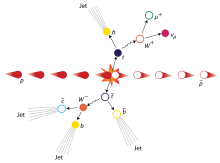Top curd
|
Top curd |
|
|---|---|
| classification | |
| Fermion | |
| properties | |
| electric charge | 2⁄ 3 e (+1.068 10 −19 C ) |
| Resting energy | (172.76 ± 0.30) GeV |
| Spin parity | 1/2 + |
| Topness | 1 |
| average lifespan | 5 · 10 −25 s |
| Decay width | 1.42 GeV |
| Interactions | Strong interaction |
The top quark is the heaviest known elementary particle . It was discovered at Fermilab in 1995 with the help of the Tevatron particle accelerator . Like all quarks , the top quark is a fermion with spin 1 ⁄ 2 , which participates in all four known fundamental interactions and has an antiparticle . The flavor quantum number associated with the top quark is the topness . Because of its low average lifespan of 5 e-25 s hadronisiertnot the top quark, so it is in contrast to the lighter quarks no bound states. In thestandard model of particle physics, the top quark is the partner particle of the much lighter bottom quark.
generation
Because of its high mass, comparable to that of a gold atom, the top quark can only be generated in extremely high-energy collisions at particle accelerators . This was possible up to 2011 at the Tevatron and from 2008 at the Large Hadron Collider (LHC).
The dominant production mechanism for the top curd is pair production . In this case, a top quark and a top antiquark are generated due to the strong interaction . The topness of the top quark is +1, while the top antiquark has a topness of −1. The topness is therefore retained in total. For pair production, at least twice the rest energy of the top quark (approx. 350 GeV) is required as the center of gravity .
Top quark can carry the weak interaction also be produced individually ( english single top quark production ). This is possible together with particle jets or in association with a W boson . Despite the lower required center of gravity energy , the associated cross sections are smaller due to the participation of the weak interaction compared to pair production.
Decay
The top quark is the only quark that is more massive than the W boson. While the W boson only appears as a virtual particle when the lighter quarks decay, top quarks decay into a real W boson and another quark, which is a bottom quark in 96% of cases. This is the reason for its extremely short lifespan. The real W boson can then hadronically decay into a quark and an antiquark, so that a total of a bottom quark, another quark and an antiquark arise (relative decay width in brackets):
- (66.5 ± 1.3)%
The (anti-) quarks in their final state hadronize to jets of hadrons .
In the case of a leptonic decay of the W boson, a charged lepton, a neutrino and a bottom quark are in the final state:
- (11.1 ± 0.3)%
- (11.4 ± 0.2)%
- (11.1 ± 0.9)%
For the decay of top antitope pairs there are three channels depending on the decay of the two W bosons, which lead to different signals in particle detectors : In the fully hadronic channel, both W bosons decay hadronically, while in the lepton-plus-jet channel (see figure) a W boson and in the dileptonic channel both W bosons decay leptonically.
history
In 1973 Makoto Kobayashi and Toshihide Masukawa postulated the existence of a third generation of quarks. The starting point was to find an explanation for the CP violation . For this, both received the 2008 Nobel Prize in Physics .
With the bottom quark, the first quark of the third generation was discovered at Fermilab in 1977. The discovery of the partner particle top quark also took place at Fermilab in 1995. For this, protons and antiprotons with a center of gravity of 1800 GeV were brought to collision at the Tevatron. The pair production of top quarks could be demonstrated by the experiments CDF and DØ .
Even before the discovery of the Higgs boson in 2012, precision measurements of the mass of the top quark could be used to determine an upper limit for the mass of the Higgs boson allowed in the Standard Model. In 2004 a mass of the Higgs boson of more than 251 GeV / c 2 could be excluded.
Evidence of the individual production of top quarks was also achieved in 2009 by CDF and DØ at the Tevatron. The individual production of top quarks in connection with a W boson could be demonstrated by the experiments ATLAS and CMS at the Large Hadron Collider in 2012 and 2013.
Individual evidence
- ↑ a b c d The information on the particle properties (info box) are taken from: PA Zyla et al. ( Particle Data Group ): 2020 Review of Particle Physics, Quarks Summary Tables. In: Prog. Theor. Exp. Phys. 2020, 083C01 (2020). Particle Data Group, accessed June 24, 2021 .
- ↑ a b P. A. Zyla et al. ( Particle Data Group ): 2020 Review of Particle Physics, Reviews: Top Quark. In: Prog. Theor. Exp. Phys. 2020, 083C01 (2020). Particle Data Group, accessed June 24, 2021 .
- ↑ Kevin Kröninger: The top quark. In: WeltDerPhysik.de. March 31, 2016, accessed June 21, 2021 .
- ↑ Fermilab | History and Archives | Experiments & Discoveries. Retrieved June 21, 2021 .
- ↑ CDF Collaboration, F. Abe, H. Akimoto, A. Akopian, MG Albrow: Observation of Top Quark Production in p p Collisions with the Collider Detector at Fermilab . In: Physical Review Letters . tape 74 , no. 14 , April 3, 1995, pp. 2626–2631 , doi : 10.1103 / PhysRevLett.74.2626 ( aps.org [accessed June 20, 2021]).
- ↑ DØ Collaboration, p Abachi, B. Abbott, M. Abolins, BS Acharya: Observation of the Top Quark . In: Physical Review Letters . tape 74 , no. 14 , April 3, 1995, pp. 2632–2637 , doi : 10.1103 / PhysRevLett.74.2632 ( aps.org [accessed June 20, 2021]).
- ↑ VM Abazov, B. Abbott, A. Abdesselam, M. Abolins, V. Abramov: A precision measurement of the mass of the top quark . In: Nature . tape 429 , no. 6992 , June 2004, ISSN 1476-4687 , p. 638–642 , doi : 10.1038 / nature02589 ( nature.com [accessed June 21, 2021]).







